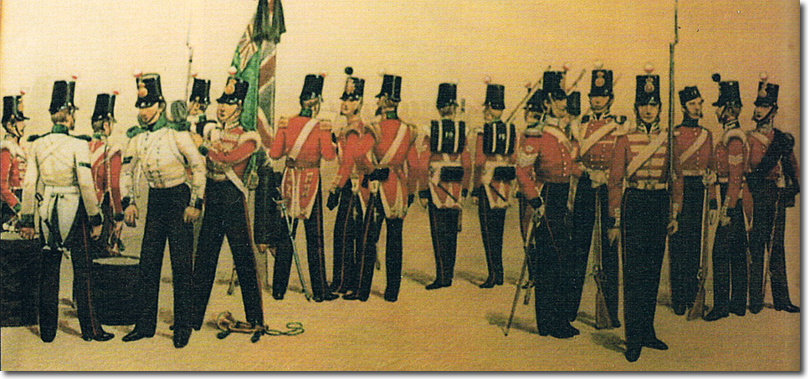|
|


|
|
This illustration by P W Reynolds is taken from a sketch made by Richard Ebsworth from life. He observed the 19th Regiment in the grounds of Guys Hospital in November 1852 as they prepared themselves for the huge funeral procession to follow the coffin of the Duke of Wellington. This explains the black crepe on the Colours and the covering of the drums. There are many figures that tell us much about the uniforms of the pre-Crimean war period. On the left are band musicians wearing white coatees with green facings. They have green rank stripes and green turn backs on their coat-tails. The back view of the lance-corporal reveals that he has a bayonet hanging from his waistbelt instead of the usual band sword. Behind them are young men of the Corps of Drums in red coatees, tufted shoulder wings and patterned tape on the seams of their coats. A drummer has put down his bugle to assist a musician with his knapsack.
A group of three officers in the middle shows the difference between a battalion company officer and two flank company officers. The one with his back to us on the left has epaulettes and a white over red battalion company ball tuft. The one on the right has a white grenadier company ball tuft, and grenade badges on his turn-backs. Interestingly he has no gold button loops on his tails like the battalion company officer. Between them is a light company officer with a green ball tuft on his shako. The swords of these officers are slung differently from their shoulder belts. The righthand group has the commanding figure of the Regimental Sergeant-Major who has four silver stripes and a crown on his right arm, silver lace covering the front of his collar, and special epaulettes on his shoulder. He has a shoulder belt, with belt-plate, for his sword, and his coatee is devoid of horizontal button lace. Other sergeants also show an absence of white lace. The private who faces us, with shouldered musket has the white button lace across his chest, in pairs, and white worsted shoulder straps. He has only one white belt, worn over the left shoulder. This holds the black ammunition pouch which sits just below his waist at the back. The bayonet is carried on his waist-belt. A man behind and just to the right of him is in undress, with a Kilmarnock cap and waist-length shell jacket. |
Armed Forces | Art and Culture | Articles | Biographies | Colonies | Discussion | Glossary | Home | Library | Links | Map Room | Sources and Media | Science and Technology | Search | Student Zone | Timelines | TV & Film | Wargames